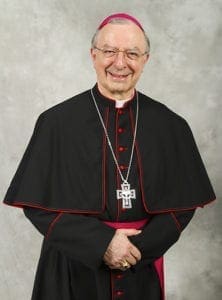An extraordinary series of popes
By BISHOP JOEL M. KONZEN, SM, Commentary | Published December 10, 2021 | En Español

Bishop Joel M. Konzen, S.M.
I was ordained a deacon in May of 1978. Just three months later, Pope Paul VI died after 15 years as pope. In that same month, Pope John Paul I was elected, but he died just 33 days later. Then, in October, Pope John Paul II was chosen, and he remained in office for the next 26 years. Hence, 1978 is often referred to as the year of three popes. As with so many things in the Catholic Church, this was not the only such occurrence; something similar had happened in 1276.
From the time, though, that I was ordained a priest in 1979, there have been only three popes in office. The first of those, John Paul II, is now St. John Paul II, and he was the third-longest serving pope in history. The second, Pope Benedict XVI, is still living in Vatican City at the age of 94. And, of course, his successor is Pope Francis, the first pope to use that name, who was elected in March of 2013. This has been quite an extraordinary series of occupants of the papal throne.
Each pope brings a unique contribution to the church. The longer a pontiff remains in office, the greater his legacy is likely to be. Pope St. John Paul II was able to visit an incredible 129 countries during his papacy, a travel record not likely to be matched unless another pope is elected, as John Paul was, before the age of 60. The impact of St. John Paul II is still being felt in the number of new religious orders and movements in the church that sprang up during his reign. His “new evangelization” and Theology of the Body have spread throughout the Catholic world. His other writings have become familiar references in the life of the Catholic Church. He is remembered, too, for having survived an assassination attempt early in his papacy.
Pope Benedict XVI was very much a scholar, a theologian who advised Pope St. John Paul II for many years. He began the reform of the Curia, the various offices of the Vatican, and was required to devote considerable attention to the matter of sexual abuse within the church. His writings continue to be popular with Catholic readers.
Pope Francis is in his ninth year as the supreme pontiff. It is still early to know what his legacy might be, but his recent calling of a worldwide Synod of Bishops and his continuing work to reform the Vatican Curia will no doubt stand out. He has also had to address the issue of the protection of minors more strenuously than his predecessors, which is hardly a glamorous undertaking but one that is undeniably necessary. His pointed reflection on care for the earth and its resources has been an abiding theme of his papacy.
No matter who the pope is, we Catholics benefit from the tradition, going back to St. Peter, of having a single leader, a central authority, who speaks for and to the church and represents the church’s teaching. While the tradition of the pope as the head of the church has been a dividing point for Catholics and other Christians at various times in history, I have heard some members of other churches voice regret that their tradition does not have that single authority who speaks definitively for the direction of their church.
We do pray for the Holy Father at every Mass, and each time that I have met the present pope, his one request is that we pray for him. His is the burden of knowing the church in all its complicated reality, but we can pray that there is joy, too, in gathering his worldwide flock to adore the King of Glory and to build up the body of Christ.